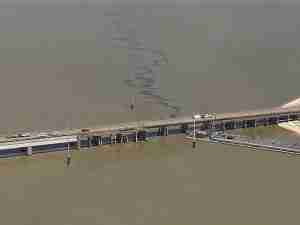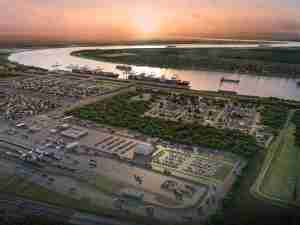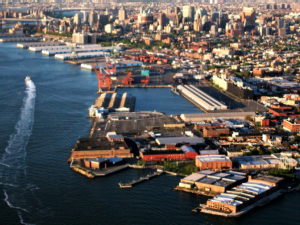Great Lakes Dredge & Dock Corporation (“Great Lakes” or the “Company”) (Nasdaq: GLDD), the largest provider of dredging services in the United States, today reported financial results for the quarter ended June 30, 2022.
Second Quarter 2022 Highlights
• Revenue was $149.4 million in the second quarter
• Total operating loss was $0.3 million in the second quarter
• Net loss was $4.0 million in the second quarter
• Adjusted EBITDA was $10.2 million in the second quarter
Management Commentary
Lasse Petterson, President and Chief Executive Officer commented, “Our second quarter results did not meet expectations as we continue to face and navigate a challenging environment driven by external factors including supply chain delays, inflationary pressures, adverse weather conditions combined with some atypical dredging project challenges.
During the quarter, three of our larger projects encountered differing and unanticipated site conditions which negatively impacted production. We are working to resolve the cost impact through contractual discussions with our customers, however revenue and profit recognition is delayed until these discussions are finalized.
Supply chain delays impacted both the Liberty Island’s and Carolina’s drydockings, which caused both dredges to be delayed several weeks mobilizing to their projects. In addition, rapidly increasing inflation impacted the cost of labor, operating supplies, and drydockings in the quarter, which we are now accounting for in bids
We also had several projects impacted by unseasonably rough sea conditions along the east coast that caused several vessels to stop operating and seek shelter, which extended completion timelines and delayed commencement of subsequent projects.
Finally, bids for new dredge projects did not materialize as early as in previous years, resulting in idle time for two dredges for part of the quarter. However, we expect bidding to increase substantially for the remainder of the year and July is already off to a strong start, in which Great Lakes was low bidder on 74% of the $250 million of work that bid in the month.
As we enter the third quarter, we expect results for the second half of 2022 to be stronger than the first, however due to the issues encountered in the first half of the year, we do not anticipate meeting full year expectations.
In spite of the current short-term challenges, the outlook for Great Lakes remains strong. We continue to see increased market demand backed by strong government support and development of new LNG export facilities that we expect will benefit Great Lakes and our market position in the upcoming years. Our new build program is on schedule with the new hopper dredge, the Galveston Island, expected to be ready for operations in the first half of 2023 and her sister ship expected to be ready for operations in 2025.
Our recently announced offshore wind award by Equinor and BP solidifies Great Lakes’ entry into the U.S. offshore wind market with a major project award for our subsea rock installation vessel currently being built for expected delivery in late 2024. Our goal is to contribute to building the U.S. offshore wind industry, which we anticipate will provide an avenue for diversification and growth for our Company.”
Quarterly Results
• Revenue was $149.4 million, a decrease of $20.5 million from the second quarter of 2021. The lower revenue in the second quarter of 2022 was due primarily to lower maintenance dredging revenue, offset partially by higher domestic capital project revenue.
• Gross margin percentage declined to 7.0% in the second quarter of 2022 from 13.5% in the second quarter of 2021. As noted above, the delayed drydockings of the Liberty Island and the Carolina negatively impacted gross margin. The New York went into her regulatory drydocking in June and is expected to remain in drydock for most of the third quarter. Gross margin was also impacted by supply chain delays, inflationary pressures, weather and atypical dredging project challenges.
• Operating loss was $0.3 million, which is a $9.1 million decrease from the prior year quarter. The decrease is a result of $12.4 million lower gross margin, offset partially by lower general and administrative expenses compared to the prior year second quarter.
• Net loss for the quarter was $4.0 million compared to net income of $2.1 million in the prior year quarter. The decrease is a direct result of lower operating income, offset partially by lower interest expense and an income tax benefit.
• At June 30, 2022, the Company had $75.4 million in cash and total long-term debt of $321.2 million.
• At June 30, 2022, the Company had $373.8 million in backlog, compared to $454.4 million in backlog at June 30, 2021.
• Capital expenditures for the second quarter of 2022 were $39.2 million, which includes $11.7 million for our new scows and multicats, $10.5 million for upgrades to the Liberty Island, the Carolina, and the booster Buster, $9.0 million for the Galveston Island build, and $2.8 million for the subsea rock installation vessel.
Market Update
At the end of 2021 the domestic dredging bid market reached $1.8 billion in projects bid. We expect the 2022 bid market to be as strong as 2021 as the market continues to be driven by the large-scale port deepening projects along the east and gulf coasts. In 2022, we expect to see the continuation of port deepening bids in the ports of Freeport, Sabine, Houston, Corpus Christi and additional phases of Norfolk, and Mobile. In addition, our nation’s coasts are subject to climate change, increasing severe weather events, like Hurricane Ida, and sea level rise, which can cause an increase in beach erosion and other damage that adds to the recurring nature of our business and the need for more frequent coastal protection and port maintenance projects.
We continue to see strong support from the Biden Administration and Congress for the dredging industry. In July, 2022 the Senate passed their version of the Water Resources Development Act 2022, or WRDA, which includes legislation that authorizes about $25 billion to help finance 20 new or modified U.S. Army Corps of Engineers (the “Corps”) projects for flood and hurricane protection, dredging, ecosystem restoration and other construction projects. Since the House passed their version also recently, the legislation is expected to be conferenced and signed into law by President Biden in short order. This is the earliest passage of this legislation in recent history.
As of July 28, 2022, both the Senate and House passed their respective fiscal year 2023 Corps budget proposals. The Senate’s proposal was $8.7 billion in funding and the House’s proposal was $8.9 billion. Prior to sending to President Biden for his signature, the House and Senate will meet to agree on a final amount, which will likely be another record budget for the Corps. This increased budget and the funding from the Biden Administration’s Infrastructure Bill support our expectation of a strong market entering 2023.
Included in our low bids pending are two liquified natural gas (“LNG”) projects that have been awaiting Notice to Proceed from our clients. Several North American LNG export projects have been delayed in the past couple of years during the pandemic as customers were unwilling to sign long-term deals needed to finance the multibillion-dollar projects. These LNG projects are currently gaining momentum as Europe is re-evaluating their sourcing of energy after the Russian invasion of Ukraine which may require imports of large quantities of LNG. There are currently several companies, including the two clients who have awarded us work, targeting to make final investment decisions in 2022 to build their plants in the United States, Canada and Mexico.
In the past year and a half, we have seen strong support for offshore wind from the Biden Administration and we believe the United States’ commitments to offshore wind will create thousands of jobs, and help the U.S. transition to a more diverse energy future. In March 2021, the White House announced new initiatives that will advance the Administration’s goals to expand the nation’s offshore wind energy capacity in the coming decade by opening new areas of development, improving environmental permitting, and increasing public financing for projects. As part of that initiative the Departments of the Interior, Energy and Commerce committed to a shared goal of installing 30 gigawatts of offshore wind power generation capacity in U.S. waters by 2030.












